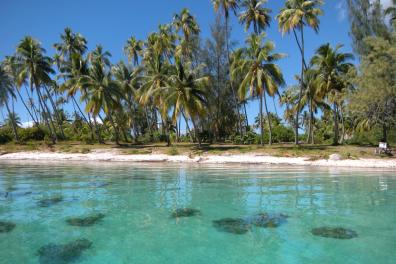Discover the language
Tahitian literature comes from a people of the Oceanic region. It is expressed in Tahitian, a Polynesian language belonging to the large Austronesian language family. It is a lingua franca, spoken in French Polynesia located in the area known as the "Polynesian triangle" in the Pacific, bounded by Hawai‛i to the north, New Zealand to the southwest and Easter Island to the southeast.
French Polynesia, whose main island is Tahiti, covers an ocean surface area of around 5 million km². According to the latest census in 2012, it has a population of 268,270. When English Protestant missionaries from the London Missionary Society arrived on March 05, 1797, to convert Polynesia to Protestantism, writing was non-existent; everything was transmitted orally. Indeed, Polynesian society, like the rest of the Oceania region, has an oral tradition, which is one of the fundamental characteristics of this civilization. These oral "works", collected for the most part by the Reverend Orsmond (a Protestant missionary from the London Missionary Society who stayed in Polynesia from 1817 to 1856), are still strongly rooted in Tahitian culture today, notably through various "performances" by traditional orators or priests, renowned for this "oratorical art" called 'Ōrero. Yet they are "rarely the subject of literary analysis".
There are different oral "genres" and they have precise denominations, specific to that society. However, it would be more appropriate to speak of "discourse" when addressing the question of "genres", as Christiane Seydou points out, and this "in order to translate more accurately the quality of enunciation, the act of communication and the social dimension".
It's also important to point out that the term "literature" didn't exist in traditional Tahitian society, and so no Tahitian terms are listed. However, "linguists" or "academics" create and propose terms to define it. One such term is Vāna'a. Tahitians or Polynesians in general, naturally and individually distinguished all these genres, without bothering to arrange them in general "categorizations" such as "literatures" or "genres".
The Polynesians, an indigenous people, had this fertile need, according to Marc Chadourne, "to adorn through eloquence, to magnify through images or symbols, to amplify through spoken or sung rhythm intimate feelings and collective passions" (Cf. BSEO No 248, Tome XXI-1, Sept.-Oct.Oct. 1989. Marc Chadourne (1895-1975) wrote novels, travelogues, particularly about Tahiti).
Tahitian is taught at Inalco within the Southeast Asia and Pacific Department.
